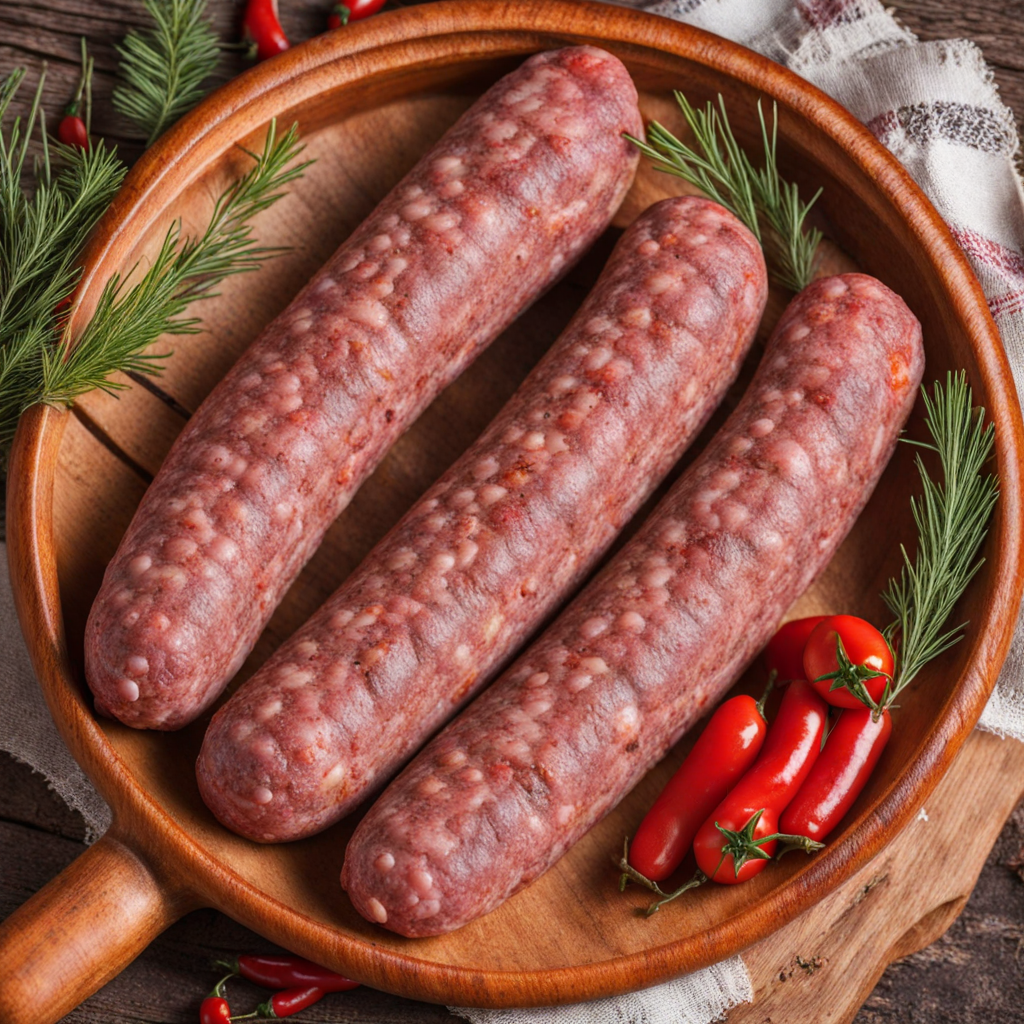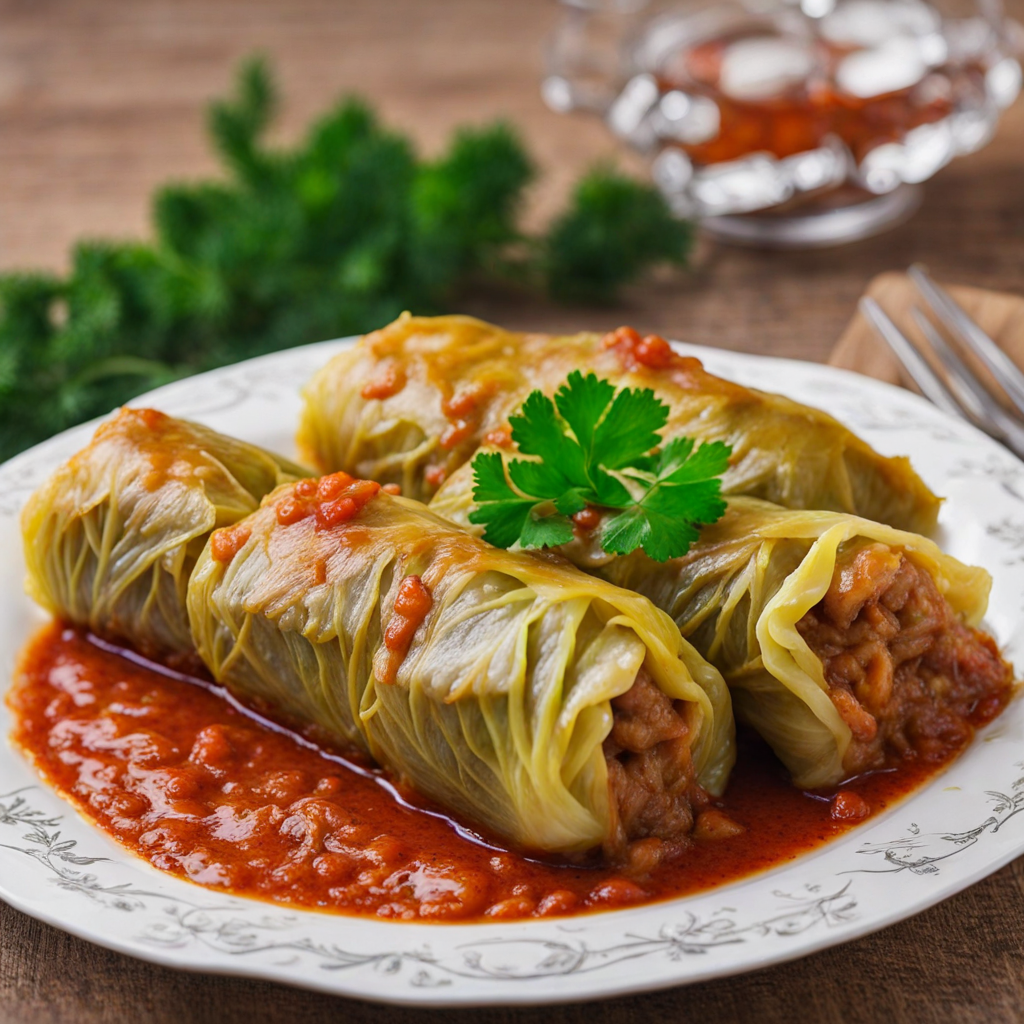Sudžuk
Sudžuk is a traditional dried sausage from Bosnia and Herzegovina, known for its rich and savory flavor profile. This delicacy is typically made from minced beef or pork, which is seasoned with a blend of garlic, salt, and a variety of spices, including paprika, black pepper, and sometimes even chili. The spices not only enhance the taste but also contribute to the sausage's deep red color, making it visually appealing. Once seasoned, the meat mixture is stuffed into natural casings and then air-dried, allowing the flavors to develop over time, resulting in a dense and flavorful product that is both aromatic and satisfying. The texture of Sudžuk is firm yet tender, offering a satisfying bite that is complemented by its rich, meaty flavor. When sliced, it reveals a vibrant maroon hue, often speckled with seasoning. Sudžuk can be enjoyed in various ways—sliced thinly as part of a charcuterie board, served as a hearty sandwich filling, or even incorporated into stews and other dishes to add depth and umami. Its versatility makes it an excellent ingredient for both casual snacking and gourmet cooking, appealing to a wide range of palates. In Bosnia and Herzegovina, Sudžuk is often enjoyed with a side of traditional bread, fresh vegetables, or cheeses, creating a delightful balance of flavors and textures. It pairs beautifully with local wines or rakija, a potent fruit brandy, making it a popular choice for gatherings and celebrations. Discovering Sudžuk is not just about tasting a new food; it’s about experiencing a piece of Bosnian culture, where food is central to hospitality and togetherness.
How It Became This Dish
The History of Suđuk: A Culinary Tradition of Bosnia and Herzegovina Suđuk, a beloved cured sausage, holds a special place in the culinary landscape of Bosnia and Herzegovina. This aromatic delicacy embodies the rich tapestry of the region's history, culture, and gastronomy. To appreciate suđuk fully, one must explore its origins, cultural significance, and the evolution it has undergone through the centuries. #### Origins of Suđuk The roots of suđuk can be traced back to the Ottoman Empire, which exerted significant influence over the Balkans from the 15th to the 19th centuries. The word "suđuk" itself is derived from the Turkish word “sucuk,” which refers to a similar type of sausage found throughout the region. The Ottomans were known for their advanced culinary techniques, including the preservation of meats. The methods they introduced, such as curing and spicy seasoning, were vital for storing meats in a time before refrigeration. Suđuk is typically made from ground beef, although variations using other meats, such as pork or lamb, can also be found. The meat is seasoned with a blend of spices, including garlic, black pepper, and paprika, which adds distinct flavor and aroma. The mixture is then stuffed into a natural casing and hung to dry, allowing air to circulate and develop its characteristic texture and taste. This method of preparation not only preserved the meat but also enhanced its flavors, making it a staple during the long winters in the Balkans. #### Cultural Significance Suđuk is more than just a food product; it is a symbol of Bosnia and Herzegovina's culinary heritage. It embodies the fusion of cultural influences that characterize the region. The Ottoman legacy is evident in the seasoning and preparation methods, while local ingredients and tastes have shaped its unique identity. In Bosnia and Herzegovina, suđuk is often associated with family gatherings, celebrations, and traditional feasts. It holds a place of honor on tables during holidays, weddings, and other significant events. The act of preparing suđuk can be a communal activity, bringing families and friends together in the kitchen to share stories, laughter, and culinary secrets passed down through generations. This communal aspect of suđuk preparation reflects the broader cultural values of hospitality and togetherness that are deeply ingrained in Bosnian society. #### Suđuk in Everyday Life In everyday life, suđuk serves as a versatile ingredient. It can be enjoyed in various forms: sliced thinly and served as part of a charcuterie board, cooked in stews, or grilled as part of a hearty meal. Its robust flavor pairs well with traditional accompaniments like homemade bread, pickles, and locally produced cheeses. Suđuk is often included in the popular Bosnian dish "sarma," where it adds depth and richness to the cabbage rolls filled with rice and minced meat. The sausage also plays a role in the street food culture of Bosnia and Herzegovina. Vendors often sell grilled suđuk in bustling markets, where locals and tourists alike can enjoy this savory treat on the go. The aroma of sizzling suđuk wafting through the air is a testament to its enduring popularity and significance in the region. #### Evolution Over Time The development of suđuk throughout the years reflects broader changes in society and culinary practices. In the early 20th century, as Bosnia and Herzegovina became part of the Kingdom of Serbs, Croats, and Slovenes, and later Yugoslavia, food traditions began to blend and evolve. Regional variations of suđuk emerged, with each locality adding its unique twist to the recipe. These adaptations often involved the incorporation of local spices or variations in preparation techniques, resulting in a diverse array of suđuk styles across the Balkans. The breakup of Yugoslavia in the 1990s brought about significant social, political, and economic changes. During this tumultuous period, traditional foods like suđuk became a source of comfort and nostalgia for many people, evoking memories of shared meals and cultural identity. The resurgence of interest in traditional foods in the post-war era led to a renewed appreciation for suđuk and other regional specialties. Home cooks and chefs alike began to explore and celebrate these culinary traditions, ensuring their continued relevance in contemporary Bosnian cuisine. #### Modern Interpretations and Global Influence In recent years, suđuk has gained recognition beyond the borders of Bosnia and Herzegovina. As the world becomes increasingly interconnected, traditional foods are often adapted and reinterpreted by global culinary enthusiasts. Chefs in diverse culinary settings have embraced suđuk, incorporating it into innovative dishes that pay homage to its roots while appealing to modern palates. In addition, the rise of the food movement advocating for local and traditional ingredients has prompted a revival of interest in suđuk as people seek to reconnect with their culinary heritage. Artisanal producers are now crafting suđuk using traditional methods, focusing on high-quality ingredients and sustainable practices, which appeals to a new generation of food lovers. This resurgence underscores the importance of preserving traditional recipes and the cultural narratives they carry. #### Conclusion Suđuk is more than just a food; it is a reflection of the rich history and cultural identity of Bosnia and Herzegovina. From its Ottoman origins to its place in modern culinary traditions, suđuk has evolved while retaining its significance as a symbol of community, heritage, and celebration. Whether enjoyed on a festive occasion or as part of everyday life, suđuk continues to bring people together, bridging generations and cultures through the timeless act of sharing food. As Bosnia and Herzegovina continues to navigate the complexities of its cultural landscape, suđuk remains a delicious testament to the resilience and richness of its culinary traditions.
You may like
Discover local flavors from Bosnia And Herzegovina







